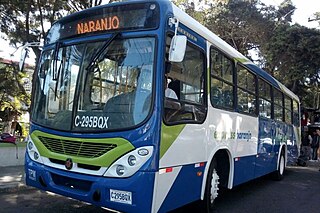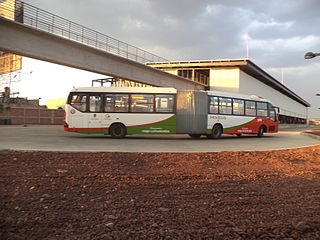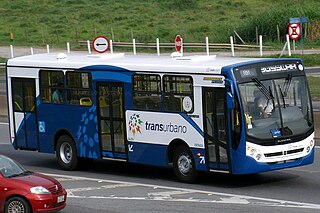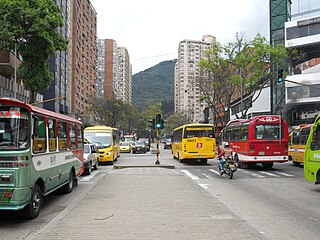
Guatemala City, known nationally also as Guate, is the capital and largest city of Guatemala. It is also a municipality capital of the Guatemala Department and the most populous urban area in Central America. The city is located in the south-central part of the country, nestled in a mountain valley called Valle de la Ermita.

TransMilenio is a bus rapid transit (BRT) system that serves Bogotá, the capital of Colombia, and Soacha, a neighbouring city. The system opened to the public in December 2000. As of 2024, 12 lines totalling 114.4 km (71 mi) run throughout the city. It is part of the city's Integrated Public Transport System, along with the urban, complementary and special bus services operating on neighbourhood and main streets.

The Mexico City Metrobús, simply known as Metrobús, is a bus rapid transit (BRT) system that has served Mexico City since line 1 opened on 19 June 2005. As of February 2018, it consists of seven lines that cross the city and connects with other forms of transit, such as the Mexico City Metro. The most recent line to open was line 7, running for the first time double-decker buses along the city's iconic boulevard, Paseo de la Reforma.

Metrorrey, officially Sistema de Transporte Colectivo Metrorrey, is a rapid transit system that serves the metropolitan area of Monterrey. It is operated by the Sistema de Transporte Colectivo Metrorrey, which is part of the decentralized public administration of Nuevo León. In 2022, it was the sixth largest metro system in North America by ridership.

Transmetro is a bus rapid transit system in Guatemala City, Guatemala. The first line opened on 3 February 2007. The fleet consists of modern Volvo buses made by Ciferal in Brazil. The buses have fixed stops and partly run on dedicated lanes, avoiding other traffic. Both stops and vehicles are guarded by municipal police. Service began in 2007 with a route between the City Hall (Municipalidad) and a market place at Centra Sur. The second route, Eje Central, started operations on August 14, 2010. This route serves the central corridor between 6th and 7th Avenue of Zones 1, 4, and 9.

Line 5, also known as the Yellow Line from its color on the system map, is a rapid transit line of the Mexico City Metro network. It travels 15.6 kilometers (9.7 mi) along the boroughs of Gustavo A. Madero, Cuauhtémoc and Venustiano Carranza in northern, northeastern and eastern Mexico City, serving thirteen stations. The line was inaugurated on 19 December 1981, going from Pantitlán to Consulado station. In 1982, the line was expanded twice, first from Consulado to La Raza station on 1 July, and later from La Raza to Politécnico station on 30 August.

The Guadalajara Mi Macro is a bus rapid transit (BRT) system in Guadalajara, Jalisco, Mexico. The initiation of work on the system was announced by Jalisco Governor Emilio González Márquez on February 29, 2008. The system was launched on March 11, 2009 by him and Mexican President Felipe Calderón Hinojosa.

Mexibús is a bus rapid transit (BRT) system that is located in the Greater Mexico City part of the State of Mexico, which surrounds Mexico City proper.

The Mexico City Metrobús Line 3 is a bus rapid transit line in the Mexico City Metrobús. It operates between Tenayuca, in the limits with the State of Mexico in Gustavo A. Madero and Pueblo Santa Cruz Atoyac in the Benito Juárez boroughs, in southern Mexico City.

The Mexico City Metrobús Line 4 is a bus rapid transit line in the Mexico City Metrobus. It operates between Colonia Buenavista, in central Mexico City and the Mexico City International Airport in the Venustiano Carranza borough, in the east of the capital.

The Rutas Express Guatemala, is an Express Public Transit system that operates from the Mixco Municipality, west of Guatemala City. This service serves local residents in Mixco and the South-west end of Guatemala City, and provides some connections to Transmetro lines. Mixco is the third most populous city in the metropolitan region surrounding Guatemala City, and was severely under served by public transit from private operators in recent years.

A centro de transferencia modal, is a type of transport hub found mainly in Mexico City. Locally known as paraderos, these intermodal passenger transport stations allow commuters to transfer between different modes of public transit, generally between rail and bus systems. In Mexico City, their operations are supervised by Organismo Regulador de Transporte (ORT). Since 14 December 2010, the hubs became part of a decentralized organization. Out of the 40 operative CETRAMs existing in the city, 33 are found adjacent to Mexico City Metro stations.

The Mexibús Line I is a bus rapid transit (BRT) line in the Mexibús system. It operates between Felipe Ángeles International Airport in Zumpango, Ojo de Agua in Tecámac and Ciudad Azteca in Ecatepec de Morelos. It was the first line to be built and to be opened. It was inaugurated by the governor of the State of Mexico, Enrique Peña Nieto on 1 December 2010 with 24 stations. Another station was opened later. It is 20 kilometers (12 mi) long and was used by approximately 130,000 users per day during 2012. The line has four different types of services, including a service exclusive for women and children. The line operates with 75 articulated Volvo 7300 BRT buses painted white with red, light green and dark green trim. It began free operations in October 2010.

The Mexibús Line II is a bus rapid transit (BRT) line in the Mexibús system. It operates between La Quebrada in Cuautitlán Izcalli and Las Américas in Ecatepec de Morelos. It was the second line to be built and the third to be opened. It was inaugurated by the governor of the State of Mexico, Eruviel Ávila on 12 January 2015 with 43 stations. It is 21.3 kilometers (13.2 mi) long. The line has two different types of services, and both include a service exclusively for women and children named Servicio Rosa. The line operates with 97 buses. On 8 October 2018, the Servicio Exprés was opened, going from Lechería to Ecatepec stations.

The Mexibús Line III is a bus rapid transit (BRT) line in the Mexibús system. It was the third line to be built and the second to be opened. It operates between Chimalhuacán, in the State of Mexico and Pantitlán metro station in Iztacalco and Venustiano Carranza, in Mexico City. It was inaugurated by the governor of the State of Mexico, Eruviel Ávila on 30 April 2013 with 29 stations. Another station was opened in 2019. In 2023, an extension was added from Chimalcuacán Municipality to Chicoloapan de Juárez. It is 23 kilometers (14 mi) long. The line operates with 85 articulated buses.

The Mexibús Line IV is a bus rapid transit (BRT) line in the Mexibús system. It operates between the Universidad Mexiquense del Bicentenario (UMB) in Tecámac and La Raza metro station in Gustavo A. Madero, Mexico City. It was the fourth line to be built and the fourth to be opened. It was inaugurated by the governor of the State of Mexico, Alfredo del Mazo Maza on 24 February 2021. It has 30 operative stations. It is 22.3 kilometers (13.9 mi) long. The line has two different types of services, and both include a service exclusively for women and children named Servicio Rosa. The line operates with 71 buses.

Mi Macro Periférico is the second BRT line in the Guadalajara metropolitan area. It runs on 41.6 kilometres (25.8 mi) along the Anillo Periférico Manuel Gómez Morin from its crossing with the Artesanos Avenue until the Solidaridad Iberoamericana Avenue, commonly known as Carretera a Chapala. It has a total of 42 stations between Carretera a Chapala and Barranca de Huentitán. The line has connections with line 1 and line 3 of the Guadalajara light rail system, lines 1 and 4 of SITREN and Mi Macro Calzada.

The Transurbano is a public bus system that serves Guatemala City. The system is operated by Siga, and funded by the government of Guatemala. The project was inaugurated during the administration of Alvaro Colom, and was supported by the Asociación de Empresarios de Autobuses Urbanos. The system was established with the goal of replacing privately operated bus service in Guatemala City, eventually amalgamating all urban bus services under the Transurbano umbrella. Service officially began on July 3, 2010, with 15 buses covering 3 routes operating in the southern part of the city between Zone 12 and Zone 21.

Guerra del centavo is the name given to a period in the history of Bogotá, capital city of Colombia, where deregulation of public transport following privatization led to an oversupply of buses throughout the city, which led to a market of monopolistic competition that created several problems, including a history of labor abuse, a decline in the quality of the service, constant increases in prices, rapid deterioration of transport-related infrastructure like streets, as well as fueling behavior that increased the likelihood of traffic-related accidents.



















